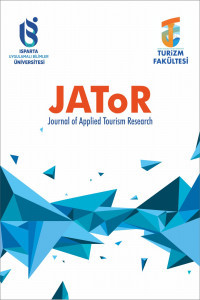ESKİŞEHİR TROPİK MERKEZİ: FARKLI BİR MİMARİ PROGRAM ÜZERİNE
Bu makalede, farklı bir mimari program olarak nitelenen Eskişehir Tropik Merkezi, tasarım fikri ve süreçleri açısından ele alınmaktadır. Canlıları salt bir sergi nesnesi olarak gören geleneksel yaklaşımın karşısında, onları koruma ve nesillerini ileriye taşıma gibi birincil amaçlar yanında, araştırma, eğitim ve bilim üretme hedefleriyle gelişen çağdaş yaklaşımların ürünü olan doğal yaşam alanları, türlerin çeşitliliğini sürdürülmesinde ve tanıtılmasında önemli rol oynamaktadır. Eskişehir Hayvanat Bahçesi’nde yer alan Tropik Merkez, canlıların doğal yaşam koşullarının sağlanması temel prensibi ile tasarlanmıştır. Ancak bu birincil prensip yanında, bağlama, zemin karakterine, canlı türü sayısına, mekanik gerekliliklere, servis ve ziyaretçi dolaşım akslarının sürekliliğine, kütlesel denge ve mekânsal dizilime bağlı pek çok farklı parametre de tasarım sürecinde etkili olmuştur. Tasarım süreci sonunda alınan kararlar ve parametrelerin etki dereceleri değerlendirildiğinde, Tropik Merkez tasarımının, örneklerine az rastlanır olması ve kendine has dinamikleri daha fazla sergilemesi nedeniyle, farklı bir mimari program olarak tanıtılabileceği ve böylece mimarlık alanına yeni bir bilgi sunabileceği düşünülmüştür.
ESKİŞEHİR TROPICAL CENTER: ON A DIVERGENT ARCHITECTURAL PROGRAM
In this study, Eskişehir Tropical Center, which is defined as a divergent architectural program, is discussed for its design idea and design process. On contrary to the approach, which handles animals just as exhibition material, the contemporary philosophy is to create natural living spaces for them in order to conserve and provide them with sustainable generations along with the taking advantage of the scientific and educative opportunities. The natural parks have great role in maintenance and introduction of such animals to the public. For similar concerns, Eskişehir Zoo shelters a variety of animals under various types of buildings. Tropical Center, one of these buildings, was designed with the basic design principle of providing the natural living conditions of the animals. However, besides this primary principle, many different parameters related to context, ground character, number of living species, mechanical requirements, continuity of service and visitor circulation axes, mass balance and spatial arrangement were also effective in the design process. When the decisions taken at the end of the design process and the degree of effectiveness of the parameters are evaluated, it was thought that the design of the Tropical Center could be introduced as a divergent architectural program.
___
- Bruni, C. M., Fraser, J., & Schultz, P. W. (2008). The value of zoo experiences for connecting people with nature. Visitor Studies, 11(2), 139-150.
- Coe, J. C. (1982). Bringing it all together: integration of context, content and message in zoo exhibit design. Paper presented at the AAZPA Annual Proceedings.
- Ehmke, L. C. (2001). 21st century zoo design. Zoo Biology: Published in affiliation with the American Zoo and Aquarium Association, 20(2), 119-122.
- Nuttall, D. B. (2004). An animal-as-client (AAC) theory for zoo exhibit design. Landscape research, 29(1), 75-96.
- Rees, P. A. (2011). An introduction to zoo biology and management: John Wiley & Sons.
